Panasonic VL-SWD501EX, VL-SWD501UEX User Manual

Operating Instructions
Wireless Video Intercom System
Model No. VL-SWD501EX
VL-SWD501UEX
Thank you for purchasing a Panasonic product.
Please read this manual before using the product and save it for future reference.
Nederlands Español Italiano Deutsch Français English
Installation Guide is supplied separately.

Table of Contents
1. Introduction |
|
|
Introduction |
|
|
............... 1.1 |
Model composition |
3 |
1.2 |
Accessory information ................................... |
3 |
1.3 |
General information ....................................... |
4 |
1.4 |
Operating procedures and icons ................... |
4 |
1.5 |
Trademarks and registered |
|
.................................................. |
trademarks |
5 |
............................... 1 6 |
Abbreviations |
5 |
2. Important information |
|
|
Important information |
|
|
.......................2 1 |
For your safety .. |
6 |
2.2 |
Important safety instructions ......................... |
7 |
2.3 |
For best performance .................................... |
7 |
2.4 |
Other important information .......................... |
7 |
3. Preparation |
|
|
Preparation |
|
|
3.1 |
Using SD cards (sold separately) ................ |
10 |
3.2 |
Controls ....................................................... |
10 |
3.3 |
Displays ....................................................... |
12 |
.............. 3.4 |
Battery installation |
14 |
3.5 |
Charging the sub monitor ............................ |
14 |
........................... 3 6 |
Wall mounting |
15 |
3.7 |
Setting the language, date and time ........... |
15 |
3.8 |
Wide/zoom settings and zoom position |
|
|
settings ........................................................ |
15 |
4. Talking/Monitoring |
|
|
Talking/Monitoring |
|
|
....................... 4 1 |
Answering calls |
17 |
4.2 |
Transferring doorphone calls ...................... |
17 |
4.3 |
Monitoring the outside with the |
|
|
doorphone ................................................... |
18 |
4.4 |
Talking between the main monitor and the sub |
|
...................................................... |
monitor |
|
5. Recording/Playing
Recording/Playing
5.1 |
Image and audio recording ......................... |
19 |
5.2 |
Recording doorphone images and |
|
............................................ |
conversations .. |
20 |
5.3 |
Playing recorded images (main monitor |
|
.......................................................... |
only) |
20 |
6.6 |
Changing camera settings .......................... |
26 |
7. Using electric locks |
|
|
Using electric locks |
|
|
7.1 |
Connecting with electric locks ..................... |
29 |
8. Incoming call operations
Incoming call operations
8.1When another incoming call is received - main
......................................................monitor |
30 |
8.2When another incoming call is received - sub
......................................................monitor |
31 |
9. Additional functions
Additional functions
9.1Changing how images are displayed (wide/
zoom and pan/tilt settings) |
..........................33 |
9.2Audio and display settings for talking and
|
monitoring ................................................... |
33 |
9.3 |
Ringtone settings ........................................ |
34 |
9.4 |
Functions settings list - main monitor .......... |
35 |
9.5 |
Function settings list - sub monitor .............. |
37 |
10. General information |
|
|
General information |
|
|
10.1 |
Registering sub monitors ............................ |
39 |
10.2 |
Using repeaters ........................................... |
39 |
10.3 |
Cancelling sub monitors, cameras, and |
|
|
repeaters ..................................................... |
40 |
10.4 |
Using SD cards (formatting/copying data/ |
|
|
playing images) ........................................... |
41 |
10.5 |
Cleaning ...................................................... |
42 |
10.6 |
Specifications .............................................. |
42 |
11. Troubleshooting |
|
|
Troubleshooting |
|
|
|
Troubleshooting .......................................... |
44 |
|
Error messages - main monitor ................... |
49 |
|
Error messages - sub monitor ..................... |
50 |
12. Index |
|
|
12.1 |
Index............................................................ |
51 |
6. Using a camera |
|
|
Using a camera |
|
|
6.1 |
Connecting with a camera ........................... |
23 |
6.2 |
Monitoring the outside with the |
|
...................................................... |
camera |
23 |
6.3 |
When camera sensors are triggered |
24 |
6.4Turning off camera sensor detections for
specified periods of time (main monitor |
|
..........................................................only) |
24 |
6.5 Recording camera images and |
|
............................................conversations .. |
25 |
2
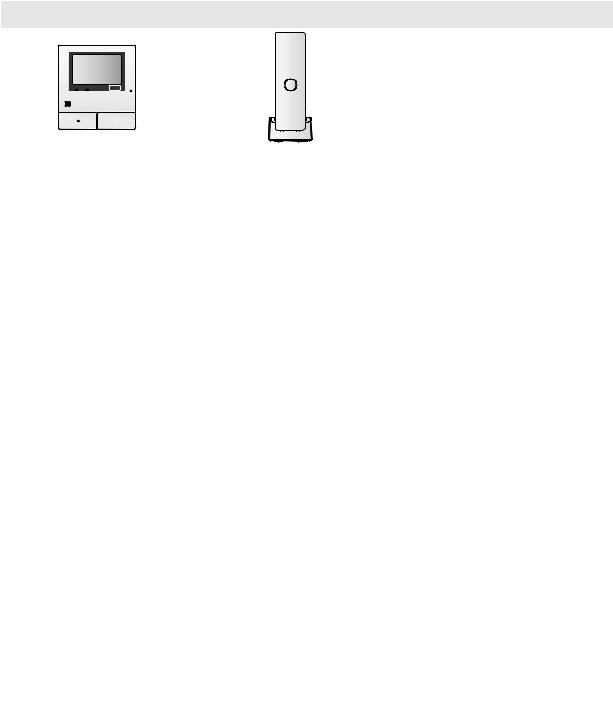
|
|
|
1. Introduction |
|
|
|
|
|
|
|
|
|
|
|
1.1 Model composition |
|
|
||
|
|
|
|
|
|
Main monitor station |
Wireless monitor |
Door station |
|
Model composition |
station |
|||
(Main monitor*1) |
(Doorphone*1) |
|||
|
(Sub monitor*1) |
|||
|
|
|
||
VL-SWD501EX |
VL-MWD501EX |
VL-WD613EX |
VL-V554EX |
|
VL-SWD501UEX |
VL-MWD501EX |
VL-WD613EX |
VL-V554UEX |
|
*1 Product names used in this manual. |
|
|
||
Product figure
VL-MWD501EX |
VL-WD613EX |
VL-V554EX (surface mount)/ |
|
|
VL-V554UEX (flush mount) |
R The illustrations in the supplied manual(s) may vary slightly from the actual product.
Caution:
R Before attempting to connect or operate this product, please read the label on the rear of the main monitor.
1.2 Accessory information
1.2.1 Supplied accessories
For the sub monitor
Accessory item
|
AC adaptor/ |
AC adaptor/ |
Rechargeable |
Charger |
|
PNLV226CE*1 |
PNLV226E*1 |
batteries |
|
Quantity |
1 |
1 |
2 |
1 |
*1 Appropriately dispose of the AC adaptor that will not be used.
Note:
RAccessories for installing the main monitor and the doorphone are described in the supplied Installation Guide.
RYou will need the following additional items (locally procured) to install the charger on the wall.
–Screws ´ 2 (for wall mounting):
Prepare the screws according to the material, structure, strength and other factors of the mounting area and the total weight of objects to be mounted.
1.2.2 Additional/replacement accessories
Please contact your nearest Panasonic dealer for sales information.
3

1. Introduction
As of November, 2013
Accessory item |
Order number |
Number of devices that can be |
|
connected |
|||
|
|
||
Rechargeable batteries |
HHR-4MVE*1 |
|
|
|
Battery type: |
- |
|
|
– Nickel metal hydride (Ni-MH) |
||
|
– 2 x AAA (R03) size for each |
|
|
|
handset |
|
|
Door station (called doorphone) |
VL-V554EX (surface mount) |
Max. of 2 (including the supplied |
|
|
VL-V554UEX (flush mount) |
devices) |
|
|
|
|
|
Sub monitor |
VL-WD613EX |
Max. of 6 (including the supplied |
|
|
|
devices) |
|
Wireless sensor camera (called |
VL-WD812EX |
Max. of 4 |
|
camera) |
|
|
|
DECT repeater (called repeater) |
VL-FKD2EX |
Max. of 2 |
|
|
|
|
*1 Replacement batteries may have a different capacity from that of the supplied batteries.
1.3 General information
R In the event of problems, you should contact your equipment supplier in the first instance.
Declaration of Conformity:
RPanasonic System Networks Co., Ltd. declares that this equipment (VL-SWD501EX/VL-SWD501UEX) is in compliance with the essential requirements and other relevant provisions of Radio & Telecommunications Terminal Equipment (R&TTE) Directive 1999/5/EC.
Declarations of Conformity for the relevant Panasonic products described in this manual are available for download by visiting:
http://www.ptc.panasonic.eu
Contact to Authorised Representative:
Panasonic Testing Centre Panasonic Marketing Europe GmbH
Winsbergring 15, 22525 Hamburg, Germany
For your future reference
We recommend keeping a record of the following information to assist with any repair under warranty.
Serial No. |
Date of purchase |
|
|
(found on the rear of the main monitor) |
|
Name and address of dealer |
|
Attach your purchase receipt here. |
|
1.4 Operating procedures and icons
n This manual provides operating procedures for the product. These operating procedures can be understood in the following way:
Main monitor example:
From the top menu of the main monitor, touch  ®
®  ® [Register/Cancel] ® [Register] ® [Camera].
® [Register/Cancel] ® [Register] ® [Camera].
Meaning
From the top menu of the main monitor, touch  ,
,  , [Register/Cancel], [Register], and then [Camera].
, [Register/Cancel], [Register], and then [Camera].
4

1. Introduction
–Words written in [ ] indicate touch buttons.
–Words written in " " indicate items or messages displayed on the screen that cannot be selected.
Sub monitor example:
 (
(  ) ®
) ®  : "Ringtone" ®
: "Ringtone" ®  (
(  )
)
Meaning
Press the round button in the centre of the multifunction button (
 ), select "Ringtone" by pressing up or down with the multifunction button (
), select "Ringtone" by pressing up or down with the multifunction button ( ), and then press the round button (
), and then press the round button ( ).
).
–Words written in " " indicate settings, items, and messages displayed on the screen.
–Words or icons written in "( )" after multifunction buttons (  ,
,  , or
, or  ) indicate the words or icons
) indicate the words or icons
displayed on the screen above the multifunction buttons. n Icons are used in the following way in this manual.
 : Indicates that the information or procedure is for the main monitor.
: Indicates that the information or procedure is for the main monitor.
 : Indicates that the information or procedure is for the sub monitor.
: Indicates that the information or procedure is for the sub monitor.

 : Indicates that the information or procedure is for the camera.
: Indicates that the information or procedure is for the camera.  : Indicates that the information or procedure is for the repeater.
: Indicates that the information or procedure is for the repeater.
1.5 Trademarks and registered trademarks
R SDXC Logo is a trademark of SD-3C, LLC.
R Mac OS, QuickTime, and the QuickTime Logo are trademarks of Apple Inc., registered in the U.S. and other countries.
R Microsoft, Windows, Windows Vista, and Windows Media are either registered trademarks or trademarks of Microsoft Corporation in the United States and/or other countries.
R The software of the sub monitor is based in part on the work of the Independent JPEG Group. R All other trademarks identified herein are the property of their respective owners.
1.6 Abbreviations
The following abbreviations are used in this manual.
RMicrosoft® Windows® XP operating system is described as Windows XP.
RMicrosoft® Windows Vista® operating system is described as Windows Vista.
RMicrosoft® Windows® 7 operating system is described as Windows 7.
RMicrosoft® Windows® 8 operating system is described as Windows 8.
RSDXC/SDHC/miniSDHC/microSDHC/SD memory card/miniSD memory card/microSD memory card are described as SD card.
5
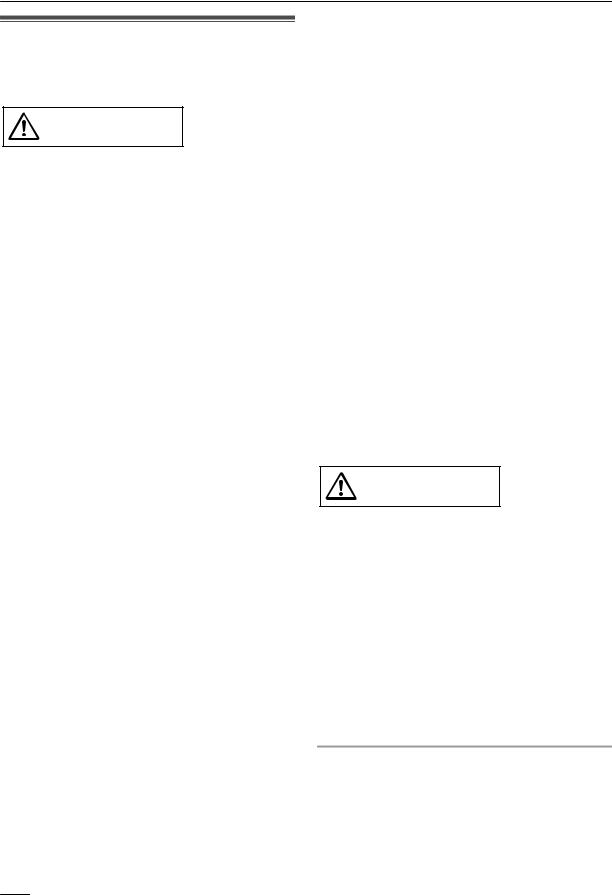
2. Important information
2.1 For your safety
To prevent severe injury and loss of life/property, read this section carefully before using the product to ensure proper and safe operation of your product.
WARNING
Preventing fire and electric shock
RUse only the power source marked on the product. If you are not sure of the type of power supplied to your home, consult your dealer or local power company.
RUse only the specified power supply unit and AC adaptor.
RDo not attempt to disassemble or modify this product. Contact an authorised service centre for repairs.
RNever touch the power supply unit and AC adaptor with wet hands.
RDo not touch the power supply unit and the AC adaptor during an electrical storm.
RDo not use the product (excluding the doorphone) in areas that are exposed to rain, moisture, steam, or oily smoke, or areas that have excessive dust.
RDo not perform any actions (such as fabricating, twisting, stretching, bundling, forcibly bending, damaging, altering, exposing to heat sources, or placing heavy objects on the power cable and the AC adaptor) that may damage the power cable and the AC adaptor. Using the product with a damaged power cable or AC adaptor may cause electric shock, short circuits, or fire. Contact an authorised service centre for repairs.
RDo not overload the power outlet or wiring above the specified levels. Overloading by having many connections on one power outlet may cause heat generation, resulting in a fire.
RNever put metal objects inside the product. Never spill any liquid on the product (excluding the doorphone).
If metal objects enter the product or the product becomes wet, turn off a circuit breaker or unplug the product from the power outlet and contact an authorised service centre.
RDo not use a microwave oven or other devices, such as electromagnetic cookers, to speed up the drying process of any parts of the product.
RCompletely insert the AC adaptor into the power outlet. Failure to do so may cause electric shock and/ or excessive heat resulting in a fire. Do not use damaged AC adaptors or power outlets.
RRegularly remove any dust, etc., from the AC adaptor by unplugging it from the power outlet, then wiping it with a dry cloth. Accumulated dust may cause an insulation defect from moisture, etc., resulting in a fire.
RTurn off a circuit breaker or unplug the product from the power outlet if the product emits smoke, an abnormal smell or makes unusual noise, or if the
product has been dropped or physically damaged. These conditions can cause fire or electric shock. Confirm that smoke has stopped emitting and contact an authorised service centre.
RHold the main body (not the metal parts) of the AC adaptor when unplugging it. Unplugging the AC adaptor while holding its cord or the cord’s plugs may result in fire, electric shock, or injury.
Preventing accidents
RSD cards may become a choking hazard. Keep SD cards out of reach of children. If you suspect a child has swallowed an SD card, seek medical advice immediately.
RDo not use the product in health care facilities if any regulations posted in the area instruct you not to do so. Hospitals or health care facilities may be using equipment that could be sensitive to external RF (radio frequency) energy.
RDo not install or use this product near automatically controlled devices such as automatic doors and fire alarms. Radio waves emitted from this product may cause such devices to malfunction, resulting in an accident.
RConsult the manufacturer of any personal medical devices, such as pacemakers or hearing aids, to determine if they are adequately shielded from external RF (radio frequency) energy. (The product operates in the frequency range of 1.88 GHz to 1.90 GHz, and the RF transmission power is 250 mW (max.).)
CAUTION
Preventing accidents, injuries, and property damage
RDo not use the product in unstable areas or areas prone to strong vibrations. This may cause the product to fall, resulting in damage to the product or injury.
RDo not put your ear(s) near the speaker, as loud sounds emitted from the speaker may cause hearing impairment.
RDo not place coins or other metal objects in the charger. Metal objects may become hot, causing burns.
RDo not place magnetic cards or other devices that store data magnetically (such as credit cards) near the charger. Failure to do so may make the cards or devices unusable.
Sub monitor batteries
Preventing leakage, heat generation, rupture, or accidents
RWe recommend using the batteries noted on page 4. USE ONLY rechargeable Ni-MH batteries AAA (R03) size.
RDo not mix old and new batteries.
RDo not open or mutilate the batteries. Released electrolyte from the batteries is corrosive and may
6

2. Important information
cause burns or injury to the eyes or skin. The electrolyte is toxic and may be harmful if swallowed.
RCharge the batteries provided or identified for use with the product only, in accordance with the instructions and limitations specified in this manual.
RDo not heat batteries or dispose of batteries in a fire.
RDo not touch the ends of batteries ( ,
,  ) with metal objects.
) with metal objects.
RHandle the batteries with care. Do not allow conductive materials such as rings, bracelets or keys to touch the batteries, otherwise a short circuit may cause the batteries and/or the conductive material to overheat and cause burns.
ROnly use the specified charger and AC adaptor to charge the batteries. Failure to follow these instructions may cause the batteries to swell or explode.
2.2 Important safety instructions
When using this product, basic safety precautions should always be followed to reduce the risk of fire, electric shock, or personal injury.
1.Do not use this product near water. For example, near a bathtub, wash bowl, kitchen sink, or laundry tub, in a wet basement, or near a swimming pool, etc.
2.Use only the power supply unit, AC adaptor, and batteries indicated in this manual.
Do not dispose of the battery(ies) in a fire. They may explode. Check with local codes for possible special disposal instructions.
SAVE THESE INSTRUCTIONS
2.3 For best performance
Location/avoiding noise (main monitor/sub monitor)
The main monitor, sub monitor, and other compatible Panasonic units use radio waves to communicate with each other. (The product operates in the frequency range of 1.88 GHz to 1.90 GHz, and the RF transmission power is 250 mW (max.).)
RFor maximum coverage (approx. 100 m) and noise-free communications, install your main monitor:
–at a convenient, high, and central location with no obstructions between the sub monitor and main monitor in an indoor environment.
–away from electronic appliances such as TVs, radios, personal computers, wireless devices, or digital cordless phones.
–facing away from radio frequency transmitters, such as external antennas of mobile phone stations. (Avoid installing the main monitor near a window.)
RCoverage and voice quality depends on the local environmental conditions.
RDo not place the charger near TVs, speakers, or other devices that emit electromagnetic waves. Failure to do so may prevent the charger from charging the product.
Environment (main monitor/sub monitor)
RKeep the unit (main monitor and sub monitor) away from electrical noise generating devices, such as fluorescent lamps and motors.
RThe unit should not be exposed to direct sunlight.
RThe unit should be kept away from heat sources such as radiators, cookers, etc. It should not be placed in rooms where the temperature is less than 0 °C or greater than 40 °C. Damp basements should also be avoided.
RDo not install the product in locations that are suspect to sudden changes in temperature. Failure to do so may cause condensation to form on the product causing malfunction.
REven when the main monitor and sub monitor are used within 100 m of each other, obstructions can cause weak signals, noise, interrupted transmissions, distorted images and slow image refresh rates. Obstructions can include:
–Metal doors or metal shutters.
–Heat insulation including aluminium foil.
–Concrete walls or walls made of galvanized iron sheet.
–If the sub monitor is being used in a different building, or a different part of the house, i.e. a different floor to the where the main monitor has been installed.
–Many walls.
–Double insulated glass windows.
RSome types of hearing aids may receive noise from wireless communications between the main monitor, sub monitor and other compatible Panasonic units.
ROperating the unit near electrical appliances may cause interference. Move away from the electrical appliances.
RIn areas surrounded by a high electrical field, disturbances may occur in the unit’s image or sound.
2.4 Other important information
RThe AC adaptor is used as the main disconnect device. Ensure that the power outlet is installed near the product and is easily accessible.
Caution:
RRisk of explosion if battery is replaced by incorrect types. Dispose of used batteries according to the instructions.
Tapping
This product uses digital wireless technology so that a call is rarely intercepted. However, calls may be tapped by a third party because the product also communicates using radio waves.
7

2. Important information
R"Tapping" means that the other party intercepts a radio message intentionally or accidentally by using a receiver.
Privacy and rights of portrait
When installing or using the doorphone, please take into consideration the rights of others with regard to privacy.
RIt is generally said that "privacy" means the ability of an individual or group to stop information about themselves from becoming known to people other than those whom they choose to give the information. "Rights of portrait" means the right to be safe from having your own image taken and used indiscriminately without consent.
Personal information
The main monitor’s internal memory and SD cards record personal information (image and audio recordings of visitors, etc.). Panasonic assumes no liability for any unforeseen damages arising from the exposure of the recorded information.
RDisclaimer
Recorded data may be altered or deleted as a result of incorrect operations, exposure to static electricity, accidents, malfunction, repairs or other operations.
Panasonic assumes no liability for any direct or indirect damages resulting from the loss or alteration of recorded images.
Requesting repairs for the product
RMake sure to back up recorded data, from the main monitor’s internal memory, to an SD card and then delete all recorded data from the internal memory before sending the product for repairs. After backing up the data, make sure to remove the SD card from the main monitor.
RAfter backing up the data, initialize the settings of the main monitor and sub monitor.*1 (All information saved to the internal memory is deleted when settings are initialized.)
–Even if the product is sent for repairs without being initialized, the memory (including recorded data and settings) for the main monitor or sub monitor may be cleared and set to factory default after repair.
–If operations cannot be performed due to the main monitor or sub monitor malfunction, consult with the place of purchase for appropriate action.
Note for product disposal, transfer, or return
RThis product can store your private/confidential information.
To protect your privacy/confidentiality, we recommend that you erase the information (recorded images) from the memory before you dispose of, transfer or return the product.
All the recorded images can be erased at once by initializing the main monitor or sub monitor.*1
RRemove the SD card from the main monitor.
–See page 10 for information about the disposal or transfer of the SD card.
*1 Main monitor: perform [Initialize settings + Delete images] in [Initialize settings]. (® page 37)
Sub monitor: perform "Initialize". (® page 38)
Information for Users on Collection and Disposal of Old Equipment and used Batteries
A B C
These symbols (A, B, C) on the products, packaging, and/or accompanying documents mean that used electrical and electronic products and batteries should not be mixed with general household waste.
For proper treatment, recovery and recycling of old products and used batteries, please take them to applicable collection points, in accordance with your national legislation and the Directives 2002/96/EC and 2006/66/EC.
By disposing of these products and batteries correctly, you will help to save valuable resources and prevent any potential negative effects on human health and the environment which could otherwise arise from inappropriate waste handling.
For more information about collection and recycling of old products and batteries, please contact your local municipality, your waste disposal service or the point of sale where you purchased the items.
Penalties may be applicable for incorrect disposal of this waste, in accordance with national legislation.
For business users in the European Union
If you wish to discard electrical and electronic equipment, please contact your dealer or supplier for further information.
Information on Disposal in other Countries outside the European Union
These symbols (A, B, C) are only valid in the European Union. If you wish to discard these items, please contact your local authorities or dealer and ask for the correct method of disposal.
Note for the battery symbol
This symbol (B) might be used in combination with a chemical symbol (C). In this case it complies with the requirement set by the Directive for the chemical involved.
Others
RIt is prohibited to disassemble or modify this product. Contact the dealer where you purchased this product for repair.
RWhen power fails, this product cannot be used.
RFor the recorded image:
8

2. Important information
The recorded image may be lost when:
–Mishandled
–Electric shock or radio wave interference occurs.
–The power is turned off during use.
RPanasonic may not be liable for damages due to external factors such as power failures.
RIf you stop using the main monitor and the doorphone, remove the main monitor and the doorphone from the walls to prevent them from falling off. (Consult your dealer for information about removing the product.)
9
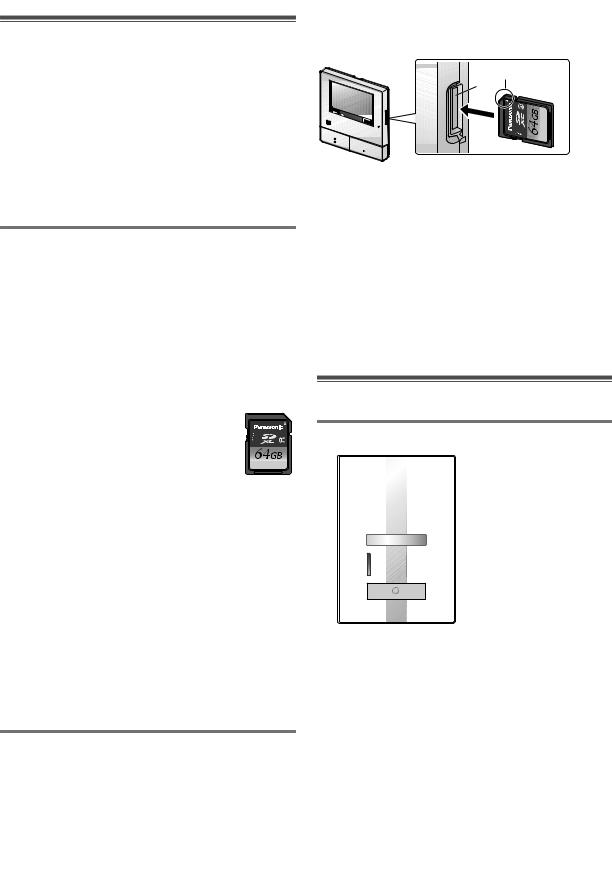
3. Preparation
3.1 Using SD cards (sold separately)
SD cards can be used with the main monitor to record images and calls from the doorphone and camera. (® page 19)
When an SD card is not used, the main monitor’s internal memory is used to save images. In this case, only doorphone images can be saved and the memory capacity is limited. We therefore recommend using an SD card to save images.
See page 42 for information about SD cards that can be used.
3.1.1 Cautions for SD cards
RThe SD card indicator (® page 11) flashes when data is being read from or written to the SD card.
Do not remove the SD card, press the RESET button (® page 11), or turn off the power to the main monitor while the SD card indicator is flashing. Failure to observe this may cause data to become corrupted.
RSD cards formatted by PCs or other devices must be formatted by the main monitor before they can be used. (® page 41)
R When the write-protect lock |
|
|
|
|
|
|
|
switch (A) is set to "LOCK", the |
A |
|
|
|
|
|
|
SD card cannot be formatted, and |
|
|
|
|
|
|
|
images and audio cannot be |
|
|
|
|
|
|
|
|
|
|
|
|
|
|
|
recorded or deleted. |
|
|
|
|
|
|
|
|
|
|
|
|
|
|
RWe recommend backing up important data to a PC or other device. Data on SD cards may become corrupted or be deleted if SD cards malfunction, or are exposed to electromagnetic waves or static electricity.
Disposing or transferring SD cards
RUsers are solely responsible for the managing of SD card data.
Formatting or deleting SD cards with the main monitor, a PC or other device, only changes the file management information and does not completely delete all data stored on the SD cards. When disposing of or transferring SD cards, we recommend physically destroying SD cards or using commercially available computer software to completely delete all data in SD cards.
3.1.2 Inserting SD cards
Important:
R Do not touch the SD card’s metal contacts.
1After confirming that the screen of the main monitor is off, insert the SD card into the SD card slot (A).
B
A
RInsert the SD card with the notched corner (B) facing upwards until it clicks into place.
RThe SD card indicator flashes and the main monitor starts to confirm the recorded image information.
2Confirm that "The SD card is ready." is displayed on the screen.
R The SD card indicator turns off and then the screen automatically turns off.
Removing SD cards
After confirming that the SD card indicator is off, push in the SD card and then remove it.
3.2 Controls
3.2.1 Doorphone
A
 D
D
E
B
C
F
G
 Lens cover
Lens cover
 LED lights (for illumination)
LED lights (for illumination)
 Name plate (supplied accessory)
Name plate (supplied accessory)
RCan be attached as required when installing the doorphone.
 Microphone
Microphone
 Camera lens
Camera lens
 Speaker
Speaker
 Call button and indicator (red)
Call button and indicator (red)
R The indicator lights in red when the power is on.
10
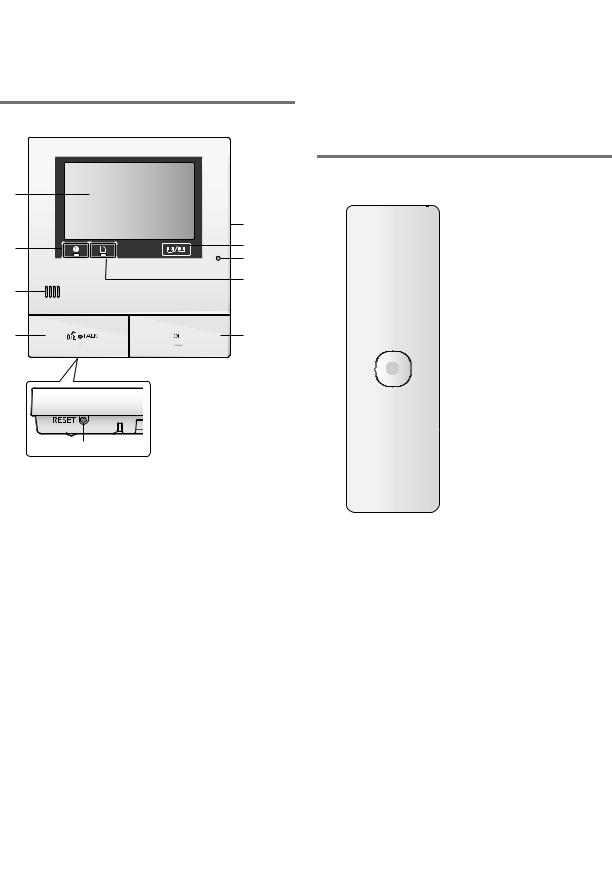
3. Preparation
Doorphone image quality
The quality of doorphone images may change depending on factors such as the installation environment and the time when images are viewed.
See page 44 for more information.
3.2.2 Main monitor
 Off button
Off button
Described in this manual as  .
.
 Reset button
Reset button
If the main monitor cannot be correctly operated, press the RESET button with a pointed object to reset the main monitor. (Recorded images and configured settings are not affected.)
A |
|
|
E |
B |
F |
|
G |
C |
H |
|
|
D |
I |
J
 Display (touch panel) (® page 12)
Display (touch panel) (® page 12)
 Notification indicator (blue)
Notification indicator (blue)
RFlashes when there is a notification. (® page 13)
–When the display is touched, the top menu is displayed and the indicator stops flashing.
3.2.3 Sub monitor
D
E
A
F
B

C

 G
G
 H
H
I
J
 Display (® page 13)
Display (® page 13)
 Multifunction buttons
Multifunction buttons
 Speaker
Speaker
 Talk button and indicator (blue)
Talk button and indicator (blue)
Described in this manual as  .
.
B
A |
RThe indicator flashes when there is an incoming call from a doorphone or sub monitor and lights when there is a call.
RWhen the  touch button is displayed on screen, calls can also be answered by touching this button.
touch button is displayed on screen, calls can also be answered by touching this button.
 SD card slot (side panel) (® page 10)
SD card slot (side panel) (® page 10)
 Displays or hides the touch buttons and icons displayed over images.
Displays or hides the touch buttons and icons displayed over images.
 Microphone
Microphone
 SD card indicator (blue)
SD card indicator (blue)
RFlashes when data is being written to or read from an SD card. (® page 10)
A Soft key icons (® page 14)
Displays the functions that can be operated by
 ,
,  , and
, and  .
.
B  is displayed in screens such as the information screen (® page 13). The arrows displayed in
is displayed in screens such as the information screen (® page 13). The arrows displayed in  indicate the direction that the button can be used in.
indicate the direction that the button can be used in.
11

3. Preparation
RIn the information screen, the volume can be changed by pressing  up or down.
up or down.

 (monitor) (® page 18, 24)
(monitor) (® page 18, 24)
 Charge indicator (® page 14)
Charge indicator (® page 14)
 Antenna (built-in)
Antenna (built-in)
RDo not cover the antenna when using the sub monitor. (This may weaken radio waves.)
 Speaker
Speaker

 (page) (® page 17, 18)
(page) (® page 17, 18)

 (off)
(off)

 (talk) (® page 17)
(talk) (® page 17)
 Microphone
Microphone
3.3 Displays
3.3.1 Main monitor - touch panel and screen information
Important:
ROnly touch the display using your fingers.
RDo not operate the display using hard and/or pointy objects (such as ball point pens), sharp objects, or finger nails.
RDo not touch or press the display with excessive force.
RDo not use commercially available LCD display protection sheets. The touch panel may not operate correctly if protection sheets are used.
RWhen there are sudden changes to the temperature, such as when a heater or cooler is turned on, the inside of the display may appear cloudy and it may not operate correctly. In this case, wait for 1 or 2 hours before attempting to operate the display.
Top menu
A
B
The top menu is the screen displayed when you touch the standby (black) screen. (Only displayed after the date and time settings have been configured, see page 15.)
Image viewing screen
C
B |
 "Have notices" is displayed when there are notifications.
"Have notices" is displayed when there are notifications.
Touch [Check] to view the notification’s contents.  Touch buttons (buttons displayed in dark blue on the
Touch buttons (buttons displayed in dark blue on the
screen)
The touch buttons change depending on the displayed screen and actions being performed.
RTouch buttons on the screen to perform operations.
–When a button is touched, a beep sounds and the button’s colour changes to orange.
–The sounds made by the main monitor can be turned off in the [Touch sound] settings. (® page 37)
–See page 12 for information about the top menu buttons.
–See page 13 for information about the main buttons displayed in the image viewing screen.
 Status information icons (® page 13)
Status information icons (® page 13)
Top menu buttons
|
Button |
Action |
||||||
|
|
|
|
|
|
|
|
|
|
|
|
|
|
|
|
|
Displays the recorded image list. (® |
|
|
|
|
|
|
|
|
|
|
|
|
|
|
|
|
|
page 20) |
|
|
|
|
|
|
|
|
|
|
|
|
|
|
|
|
|
R "New" is displayed when there |
|
Recorded |
are messages that have not been |
||||||
|
image list |
|||||||
|
|
|
|
|
|
|
|
viewed. |
|
|
|
|
|
|
|
|
Monitors the doorphone or camera. |
|
|
|
|
|
|
|
|
(® page 18, 24) |
|
|
|
|
|
|
|
|
|
|
|
|
|
|
|
|
|
Calls/pages the sub monitor. (® |
|
|
|
|
|
|
|
|
page 18) |
|
|
|
|
|
|
|
|
|
|
|
|
|
|
|
|
|
Displays the settings menu. (® |
|
|
|
|
|
|
|
|
page 26, 35) |
12
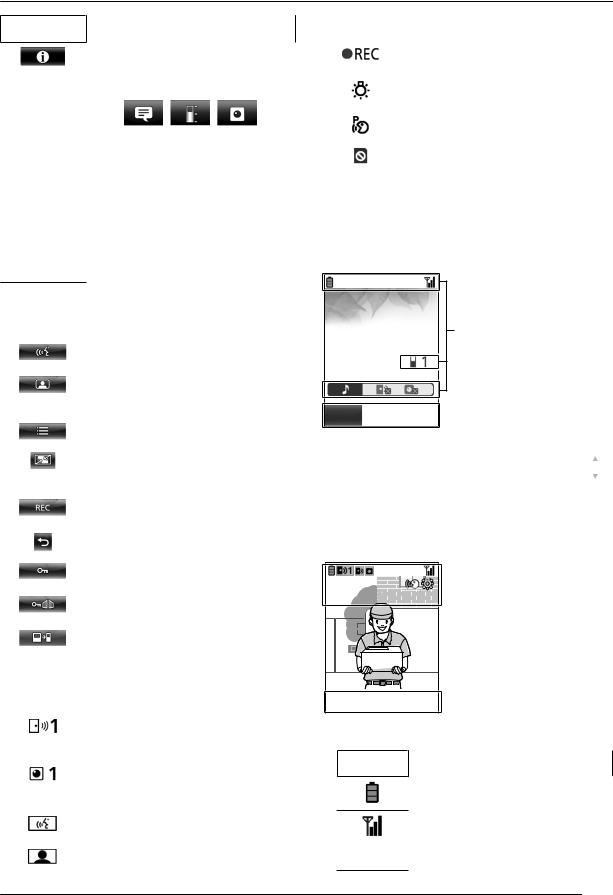
3. Preparation
Button |
Action |
|
|
Displays the following information menus:
A B C
RTouch the button of the menu that you want to check.
A Displays notifications for the main monitor and camera.
B Displays the recording information (save destination, available memory, etc.).
C Displays whether the sensors have been enabled and if the camera can be connected to.
Main buttons in the image viewing screen
Button |
Action |
|
|
|
Answers or starts a call with the |
|
displayed visitor. |
|
Monitors the displayed visitor. |
|
(Sound and images can be |
|
monitored.) |
|
Displays menus. |
|
|
|
Changes the display from wide |
|
display to entire image display. (® |
|
page 33) |
|
Records the displayed image. (® |
|
page 20, 25) |
|
Returns to the previous screen. |
|
|
|
Unlocks the electric door lock. (® |
|
page 29) |
|
Unlocks the electric vehicle gate lock. |
|
(® page 29) |
|
Transfers calls from the main monitor |
|
to the sub monitor. (® page 17) |
Status information icons |
|
|
|
Icon |
Meaning |
|
|
|
Indicates which doorphone is calling, |
|
monitoring, or on a call. |
|
("1" indicates the device number.) |
|
Indicates which camera is calling, |
|
monitoring, or on a call. |
|
("1" indicates the device number.) |
|
Indicates that the main monitor is on |
|
a call. |
|
Indicates that the main monitor is |
|
monitoring. |
Icon |
Meaning |
|
|
|
Indicates that images are being |
|
recorded. (® page 20) |
|
Indicates that the doorphone’s LED |
|
lights are on. (® page 34) |
|
Indicates that "Press-to-talk" mode is |
|
on. (® page 17) |
|
Indicates that the write-protect lock |
|
switch of this SD card is set to |
|
"LOCK", or an SD card that cannot be |
|
recorded to is inserted. (® page 10) |
|
|
3.3.2 Sub monitor - monitor display
Information screen
A


 B
B
The information screen is displayed when the sub monitor is taken off the charger, or  ,
,  ,
,  ,
,
or  are pressed when the screen is off.
are pressed when the screen is off.
Talking/monitoring screen
|
|
|
|
|
|
|
A |
||
|
|
|
|
|
|
||||
|
|
|
|
|
|
|
|
|
|
|
|
|
|
|
|
|
|
|
|
|
|
|
|
|
|
|
|
|
|
|
|
|
|
|
|
|
|
|
|
|
|
|
|
|
|
|
|
|
|
|
|
|
|
|
|
|
|
|
|
|
|
|
|
|
|
|
|
|
|
|
|
|
|
|
|
|
|
|
|



 B
B
 Status information icons
Status information icons
Icon |
Meaning |
|
|
Battery level. (® page 15)
Range status: The more bars displayed, the stronger the signal between sub monitor and main monitor.
13
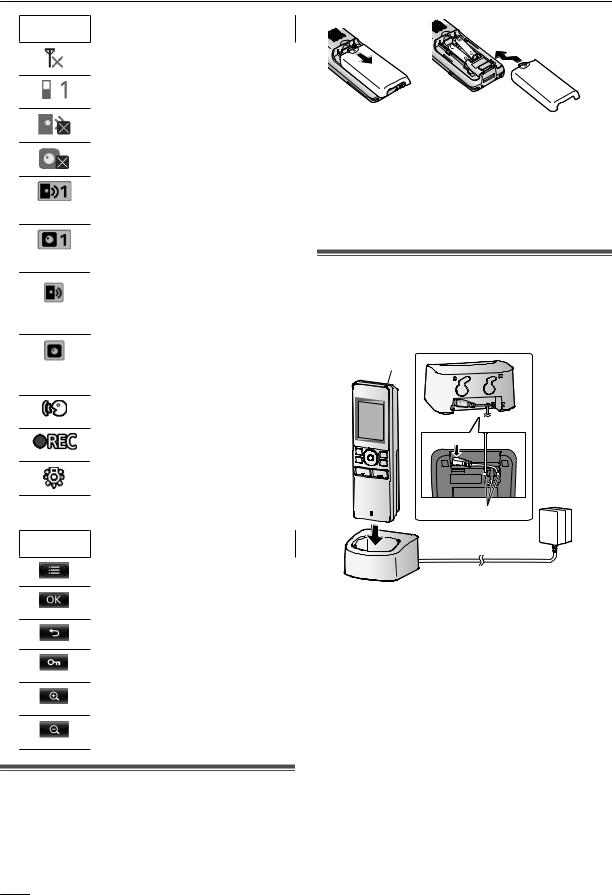
3. Preparation
Icon |
Meaning |
|
|
Out of range.
Indicates the number of the sub monitor being used.
Indicates that the doorphone’s ringtone volume is muted.
Indicates that the camera’s ringtone volume is muted.
Indicates which doorphone is calling, monitoring, or on a call. ("1" indicates the device number.)
Indicates which camera is calling, monitoring, or on a call.
("1" indicates the device number.)
Indicates there is a call from the doorphone when calling, monitoring, or on a call with another device. (® page 32)
Indicates there is a call from a camera when calling, monitoring, or on a call with another device. (® page 32)
Indicates that "Press-to-talk" mode is on. (® page 17)
Indicates that images are being recorded. (® page 20)
Indicates that the doorphone’s LED lights are "On". (® page 34)
 Soft key icons
Soft key icons
Icon |
Action |
|
|
Displays menus.
Executes the selected item or operation.
Returns to the previous screen.
Unlocks the electric lock. (® page 29)
Changes the display to zoom display. (® page 33)
Changes the display to wide display. (® page 33)
3.4 Battery installation
–USE ONLY rechargeable Ni-MH batteries AAA (R03) size.
–Do NOT use Alkaline/Manganese/Ni-Cd batteries.
–Confirm correct polarities ( ,
,  ).
).
Note:
RUse the supplied rechargeable batteries (Ni-MH ONLY). For replacement, we recommend using the Panasonic rechargeable batteries noted on page 4.
RWipe the ends of batteries ( ,
,  ) with a dry cloth.
) with a dry cloth.
RAvoid touching the ends of batteries ( ,
,  ) or the unit contacts.
) or the unit contacts.
3.5 Charging the sub monitor
Only connect the charger with the supplied Panasonic AC adaptor (® page 3).
AC adaptor connections
A
*1
B
*1 Press plug firmly.
RConnect the charger to the power outlet, and then place the sub monitor in the charger to charge it. Charging usually takes about 8 hours.
A Charge indicator
–when charging: lights
–when charging is completed: off
B Hook
RCharging may take longer in the following situations.
–When the operating temperature is low. (® page 43)
–When the sub monitor is picked up off the charger or used during charging.
–When the sub monitor’s signal is out of range (  ). (® page 14)
). (® page 14)
RThe sub monitor does not overcharge even if it is continuously placed in the charger.
14
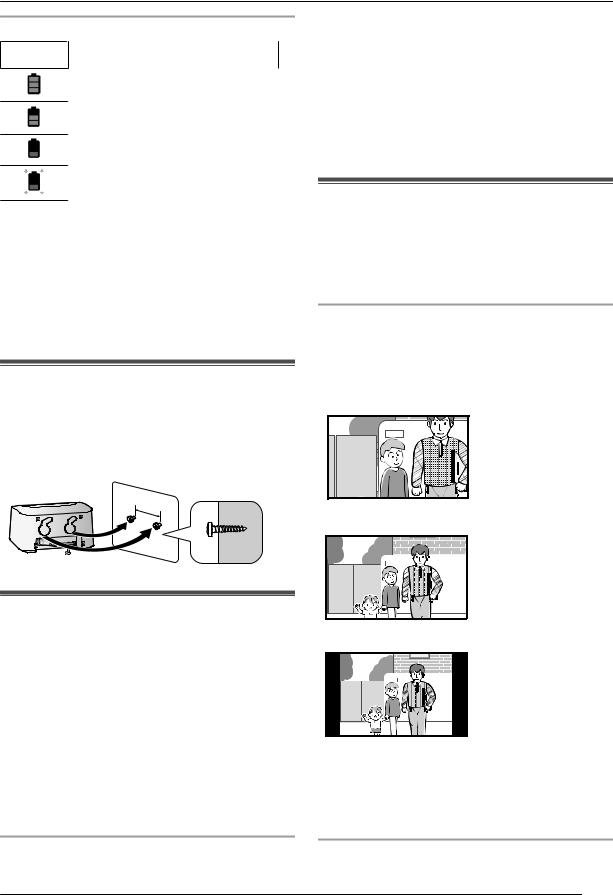
3. Preparation
Battery level
Icon |
Battery level |
|
|
High
Medium
Low
Needs charging
RSee page 43 for a guide on operating times for the sub monitor.
Note:
RWhen the sub monitor is off the charger or the AC adaptor is disconnected for 1 week or more, remove the batteries in order to maintain battery performance and prevent the batteries from discharging.
–Recharge the batteries before using the sub monitor again.
3.6 Wall mounting
Note:
RMake sure that the wall and the fixing method are strong enough to support the weight of the unit.
RDrive the screws (locally procured) into the wall.
25mm
3.7Setting the language, date and time
–This operation can only be performed on the main monitor.
A language selection screen is displayed when the main monitor is first used. Follow the steps below to configure the language, date and time. (The notification indicator flashes when these settings have not been configured.)
1Touch the language that you want to use and then touch [Next].
2 Configure the date and time by touching [+] and [–].
3Touch [OK] to complete the settings.
R A beep sounds and the screen turns off.
Changing the language, date and time
The language, date and time can be changed from the settings button in the top menu. (® page 35)
Note:
RThe sub monitor’s language (including the language of additionally registered sub monitors) is automatically matched to the main monitor’s language setting.
RThe date and time settings may be deleted when there is a power outage. In this case, reconfigure the settings.
RThe time may get out of sync by about 60 seconds a month.
3.8 Wide/zoom settings and zoom position settings
–This operation can only be performed on the main monitor.
You can configure how doorphone images are initially displayed on the main monitor and sub monitor.
Wide/zoom settings
From the following 3 settings, you can select how images are initially displayed when visitors come or when monitoring.
Zoom display*1
(images are zoomed in |
on 2 times more that in |
wide display) |
Wide display*2 (default setting)
Entire image display (main monitor only)
*1 Because a digital zoom is used, image quality is lower when compared to images in wide display or entire image display.
*2 The top and bottom parts of wide display images on the main monitor are cut off when compared to images in entire image display.
Zoom position settings
You can configure which parts of images are zoomed in on when displaying zoomed images. Adjust the position
15

3. Preparation
so that the people or objects that you want to view are displayed centrally in the screen.
Settings:
1.From the top menu, touch  ®
®  ® [Initial settings].
® [Initial settings].
2.Configuring wide/zoom settings:
ATouch [Wide/Zoom settings] and then select the doorphone to be configured.
BTouch [When visitors come] or [When monitoring], and then select the display method (Zoom, Wide, or All).
R A beep sounds and the settings are changed.
CTo end the operation, press  .
.
Configuring zoom position settings:
A[Zoom position settings] ® select the doorphone to be configured.
(The current doorphone image is displayed in the wide display.)
BTouch the position that you want to be zoomed in on, and then touch [OK] after confirming the selected position.
R A beep sounds, "Configured" is displayed, and then the screen automatically turns off.
Note:
RWhen [Zoom] is selected for [Wide/Zoom settings]:
–Adjust the zoom position so that people or objects that you want to view are displayed centrally in the screen. (® page 15)
–When images are recorded, only the areas displayed when zooming are recorded.
RThe zoom position screen automatically turns off if settings are not completed in about 90 seconds. In this case, settings are not saved and must be redone.
16

4. Talking/Monitoring
4.1 Answering calls
–This operation is the same for the main monitor and sub monitor.
When you receive a call from a doorphone, the main monitor and sub monitor ring and display an image from the doorphone. You can answer calls with the following operations.
1Press  and talk to the visitor.
and talk to the visitor.
R Speak alternatively with the visitor (staying within about 50 cm from the microphone).
–If you and the visitor speak at the same time, you will not hear each other.
–Talking time: up to about 90 seconds.
2 To end the operation, press  .
.
Features available while talking or when there is an incoming call
–Monitor visitors (incoming call only)
 : Touch
: Touch  .
.
 : Press
: Press  .
.
–Adjust wide/zoom and pan/tilt settings (® page 33)
–Adjust sound and display settings (® page 33)
–Talk using "Press-to-Talk" (® page 17)
–Transfer calls (® page 17)
–Unlock electric locks (® page 29)
Note:
RThe display will turn off if you do not answer a call within about 30 seconds.
RIncoming call images are automatically recorded to the main monitor. (® page 20)
4.1.1 Press-to-talk mode
If it is difficult for you or the visitor to hear each other due to noise, the "Press-to-talk" mode can be used to make conversations easier to hear. Speak with the visitor
alternately by pressing  to switch between the
to switch between the
talking mode and the receiving mode. (You can operate this feature in the same way by using either the main monitor or the sub monitor.)
1Press and hold  for about 2 seconds during a call until a beep sounds.
for about 2 seconds during a call until a beep sounds.
R (or
(or  ) is displayed on the screen.
) is displayed on the screen.
2To speak to the visitor:
Speak while pressing and holding  .
.
To hear the visitor:
Release  .
.
Note:
R "Press-to-talk" mode is cancelled after the call ends.
4.2 Transferring doorphone calls
You can transfer a doorphone call between the main monitor and the sub monitor.
RWhen using multiple sub monitors, you can transfer a doorphone call between the sub monitors.
To transfer calls
1. : While talking to the visitor at the doorphone, touch
: While talking to the visitor at the doorphone, touch  .
.
R When there are multiple devices that can be selected, select the device. To page all devices, touch [Call all together].
 : While talking to the visitor at the doorphone, press
: While talking to the visitor at the doorphone, press  .
.
RWhen there are multiple devices that can be selected:
 : Select the device.*1 ®
: Select the device.*1 ®  (
(  )
)
*1 To page all devices, select "Call all together".
2.Page the other party.
3.When the paged party answers, ask them to receive the call from the doorphone. Perform the following to transfer the call to the paged party.
 : Touch [Transfer to sub monitor].
: Touch [Transfer to sub monitor].
 : Press
: Press  .
.
To receive calls
–This operation is the same for the main monitor and sub monitor.
1.When the intercom call is received, press  to talk to the paging party.
to talk to the paging party.
2.When the image from the doorphone is displayed, talk to the visitor.
3.To end the operation, press  .
.
Note:
R The visitor cannot hear voices during paging.
17
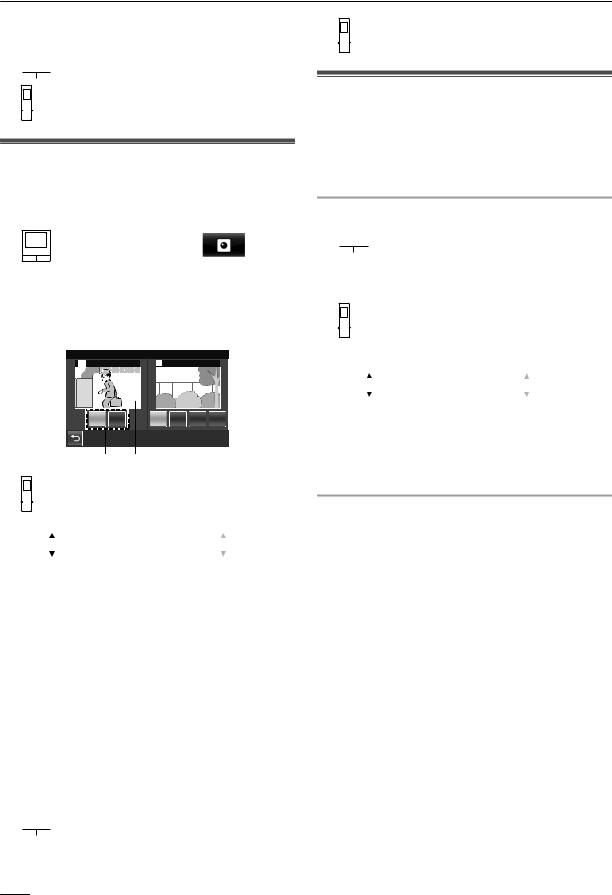
4. Talking/Monitoring
RTo talk to the visitor if the paged party does not answer:
 : Touch [Talk to visitor].
: Touch [Talk to visitor].
 : Press
: Press  .
.
4.3 Monitoring the outside with the doorphone
You can monitor the sounds and images from the doorphone.
1 |
: From the top menu, touch |
. |
RWhen there are multiple devices displayed, touch the number of the doorphone that you want to monitor with (A) and then the image (B).
Example: When there are both doorphones and cameras.


A B
 : Press
: Press  .
.
RWhen there are multiple devices displayed:  : Select the destination. ®
: Select the destination. ®  (
(  )
)
2The images from the doorphone are displayed.
R Press  to speak to the monitored party.
to speak to the monitored party.
3 To end the operation, press  .
.
Features available while monitoring
–Adjust wide/zoom and pan/tilt settings (® page 33)
–Adjust sound and display settings (® page 33)
–Record monitored images (® page 20)
Note:
RThe sound from your end will not be heard at the doorphone.
RMonitoring time:
 : About 90 seconds (can be extended up to 3 minutes by performing operations during monitoring)
: About 90 seconds (can be extended up to 3 minutes by performing operations during monitoring)
 : About 3 minutes
: About 3 minutes
4.4 Talking between the main monitor and the sub monitor
Intercom calls between the main monitor and the sub monitor can be made.
–When using multiple sub monitors, you can make intercom calls between the sub monitors.
To make calls
1. : From the top menu, touch
: From the top menu, touch  .
.
R When there are multiple devices that can be selected, select the device. To call all devices, touch [Call all together].
 : Press
: Press  .
.
RWhen there are multiple devices that can be selected:
 : Select the device.*1 ®
: Select the device.*1 ®  (
(  )
)
*1 |
To call all devices, select "Call all together". |
|
2.Page the other party.
3.Talk with the paged party when they answer the call.
4.To end the operation, press  .
.
To receive calls
–This operation is the same for the main monitor and sub monitor.
1.When the intercom call is received, press  to talk to the paging party.
to talk to the paging party.
Note:
RPaging automatically ends after about 30 seconds and intercom calls automatically end after about 90 seconds.
18

5. Recording/Playing
5.1 Image and audio recording
The amount of audio and image content that can be recorded depends on the where the content is being saved (internal memory or SD card).
In order to enjoy the full capabilities of the product, we recommend using an SD card for the save destination.
–When an SD card is inserted into the main monitor, it automatically becomes the default save destination. (The save destination cannot be selected.)
–See page 10 for information about supported SD cards and how they are used.
|
|
|
Internal memory |
Save destination |
SD card (2 GB - 64 GB) |
(when an SD card is |
|
|
|
|
not inserted) |
Maximum number of images |
3,000*1 |
50 |
|
Recorded image type |
Doorphone images |
Camera images and |
Doorphone images |
|
and calls |
calls |
only |
|
(® page 20) |
(® page 25) |
(® page 20) |
|
Incoming call |
|
Series of images |
|
|
recordings |
|
|
|
|
|
recorded at 1 second |
|
|
|
(automatic |
Video: max of |
|
|
|
intervals and audio: |
Still images: max of 8 |
||
|
recording) |
approx. 30 seconds |
||
|
max of approx. 30 |
|
||
Content of |
Monitor recordings |
|
|
|
|
seconds |
|
||
each |
(manual recording) |
|
|
|
recording |
|
|
Series of images |
|
|
|
Video and audio: |
recorded at 1 second |
|
|
Talk recordings |
max of approx. 90 |
intervals and audio: |
Cannot record |
|
|
seconds*2 |
max of approx. 90 |
|
|
|
|
seconds*2 |
|
*1 Differs depending on the capacity of the SD card. See page 19 for a guide to the capacity and number of images that can be recorded with SD cards.
*2 See page 36 for audio recording settings in [Record calls] for the doorphone and camera.
Note:
RRecorded images from the internal memory can be copied to SD cards. (® page 41)
RImages recorded on SD cards can be played on a PC. (® page 41)
Guide for SD card capacity and recording
The following table gives an approximate guide to the number of images that can be recorded, based on which device took the images and the size of the SD card used, when the default settings are used ([Record calls] is set to [Disable] (® page 36)).
Unit: number of recorded images
|
Capacity |
2 GB |
4 GB |
8 GB |
16 GB |
32 GB |
48 GB |
64 GB |
|
Doorphone |
125 |
255 |
520 |
1,040 |
2,090 |
3,000 |
3,000 |
Recorded |
images only |
|
|
|
|
|
|
|
image type |
Camera images |
2,300 |
3,000 |
3,000 |
3,000 |
3,000 |
3,000 |
3,000 |
|
only |
|
|
|
|
|
|
|
Note:
RWhen using a camera, we recommend using an SD card with a capacity of 4 GB or more.
RThe number of images that can be recorded in the table are just a guide and may differ from the actual number of images that can be recorded.
RBecause SD cards contain data such as file system management information, the complete capacity cannot be used to save data. When other data is saved to an SD card, the number of images and videos that can be saved is reduced.
19

5. Recording/Playing
5.2 Recording doorphone images and conversations
5.2.1 Automatically recording incoming call images
When there is an incoming call, regardless of whether you answer the call or not, images are automatically recorded about 2 seconds after receiving the call. (See page 19 for information about the recorded contents.)
When calls are not answered:
Recorded images are saved as unchecked images, and the notification indicator of the main monitor flashes.
Note:
RWhen there is an incoming call from another doorphone when talking or monitoring with a doorphone (® page 30), you must end the call or monitoring in order to display and save the image from the incoming call.
RWhen there are multiple doorphones and there is an incoming call from another doorphone, while receiving an incoming call, the number of recorded images (8 images), and the length of recorded videos (about 30 seconds), are reduced.
When the internal memory or SD card’s memory is full (auto image updating)
When the memory is full, it is not necessary to manually delete images in order to record new messages because existing images, starting with the oldest image, are automatically deleted.
–Images that have not been viewed are also deleted.
–See page 13 for information about checking the recording status of the internal memory or SD card.
5.2.2 Record images and audio until the end of calls (Record calls)
To use this function, an SD card must be in the main monitor and [Record calls] must be appropriately configured (® page 36).
In this case, when calls from a doorphone are answered, the calls can be recorded from start to finish in 1 video file that includes audio data. (The maximum length of the video is about 120 seconds.)
5.2.3 Manually recording monitored images
Monitored images can be manually recorded with the main monitor and sub monitor. (See page 19 for information about the recorded contents.)
Images monitored with the camera can also be recorded with the same operations.
1Perform the following operations when monitored images are displayed.
R |
is displayed on the screen when |
recording.
 : Touch
: Touch  .
.
 :
:  (
(  ) ®
) ®  : "Record" ®
: "Record" ®  (
(  )
)
Note:
RWhen recording images with the sub monitor, because there is a lag from when operations are performed to when recording actually starts, there may be a difference between the contents of the monitored images and the recorded images.
5.3 Playing recorded images (main monitor only)
When there are recently recorded images that have not been viewed, the notification indicator flashes and "New" is displayed.
1From the top menu, touch [Recorded image list].
R A list of recorded images for each day is displayed in a 1 week calendar.
–To view a recorded image list from another day, touch the button of the desired date. This will show all recorded images from that day.
–Touch  to view a list of camera recorded images.
to view a list of camera recorded images.
–See page 21 and 22 for information about how to navigate this screen and play images.
2Touch the image that you want to view.
R Touch  to view all of the images after the selected date.
to view all of the images after the selected date.
3 To end the operation, press  .
.
Note:
RThe notification indicator stops flashing when the top menu is displayed, and "New" in the top menu disappears from the display when the recorded image list screen is displayed.
20
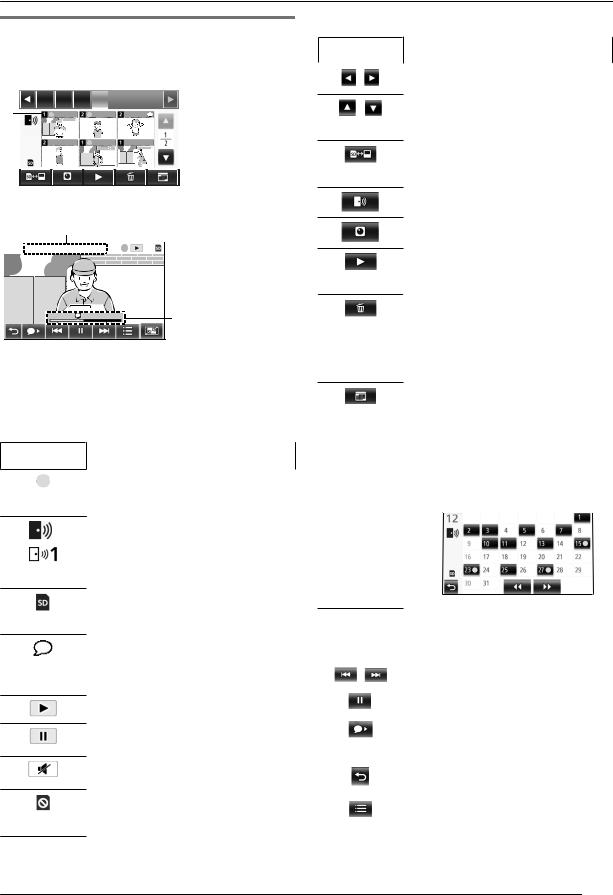
5. Recording/Playing
5.3.1 Navigating the recorded image list and image playing screens
Recorded image list screen




A
Image playing screen
B


C
 The recording device’s number
The recording device’s number
 Recording date and time
Recording date and time
 Time that the image has been played for
Time that the image has been played for
Display and other icons
Icon |
Meaning |
|
|
Indicates that there is an image that has not been viewed, and which images have not been viewed.
Displayed when images from a doorphone are displayed.
When images from a camera are displayed,  or
or  is displayed.
is displayed.
Indicates that an image recorded on the SD card is being displayed or played.
Indicates there is recorded audio (displayed at the start position of recorded calls in the playback screen).
Displayed when playing images.
Displayed when images being played are paused.
Displayed when the audio is muted. (® page 22)
Displayed when the write-protect lock switch of the SD card is set to "LOCK". (® page 10)
Operation buttons in the recorded image list screen
Button |
Action |
|
|
/ |
Go to the previous or next week. |
|
/Go to the previous or next page (only displayed when there are 7 or more recorded images).
Switches the memory (internal memory or SD card) that recorded images are displayed from.
Goes to the doorphone’s image list.
Goes to the camera’s image list.
Plays images from the selected date and all images recorded after that date.
Deletes all images from the selected day.
RTo delete:
Touch  ® confirm the
® confirm the
message and then touch [Yes].
Allows you to search for images using the calendar (this is convenient for searching for an image when there are many recorded images).
RWhen touched, a calendar such as the following is displayed. Touch the date button of the images that you want to view.
Operation buttons in the playing screen
Button |
Action |
|
|
/ |
Skips to the next or previous image. |
|
|
|
Pauses images. |
|
|
|
When audio is recorded with an |
|
image, audio is played from the start |
|
of recorded calls. |
|
Returns to the recorded image list |
|
screen. |
|
Allows you to delete images, and |
|
adjust the brightness and volume. |
|
(® page 22) |
21

5. Recording/Playing
Button |
|
Action |
|
|
|
|
|
/ |
/ |
Switches between wide, entire |
|
image, and zoom displays. (® |
|||
|
|
||
|
|
page 33) |
|
|
|
R The display can also be zoomed |
|
|
|
by touching an image. |
|
|
|
Plays paused images. |
|
|
|
|
|
/ |
|
Skips to the next or previous frame |
|
|
|
(image). |
|
|
|
|
5.3.2 Menu button functions when playing images
The following operations can be performed by using the button displayed when playing images.
Deleting individual images:
Images can be deleted 1 image at a time.
RTouch [Delete], check the displayed message and then touch [Yes].
Changing the screen’s brightness:
RTouch [Brightness], and then adjust the brightness by touching [–] (Darker) or [+] (Brighter).
Changing the volume of played images:
The volume can be changed when playing the images.
RTouch [Volume], and then adjust the volume by touching [–] (Quieter) or [+] (Louder).
–To mute the audio, touch [–] until  is displayed.
is displayed.
Note:
RThe [Delete all images] setting can be used to delete all images in the save destination (internal memory or SD card) in a single operation. (® page 36)
22
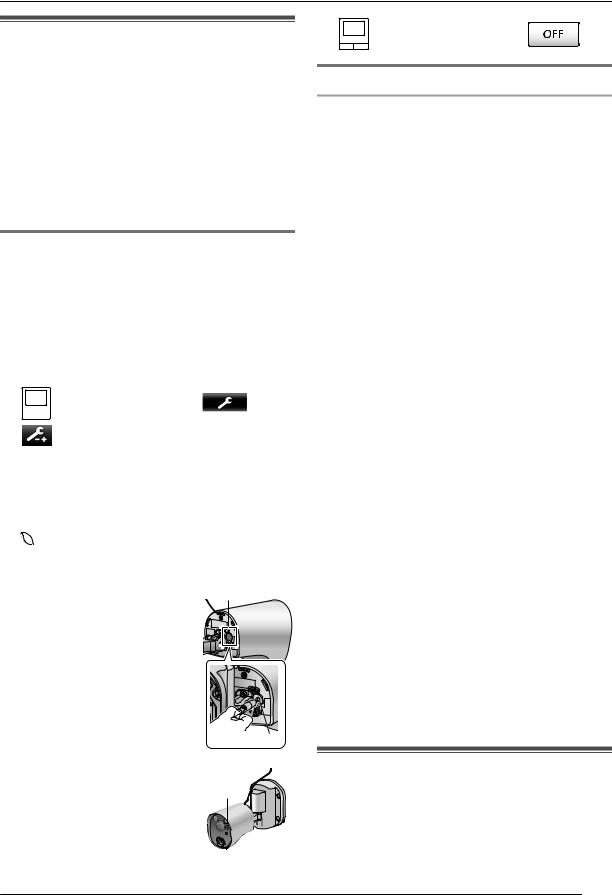
6. Using a camera
6.1 Connecting with a camera
By connecting with a camera (additional accessories, ® page 4), you can monitor outside images with the camera, and the main monitor and sub monitor can receive notifications with sounds and images when camera sensors are triggered.
–See the camera’s manuals for detailed information about using the camera.
–An SD card is required to record camera images.
Note:
RThe image quality of camera images may be lower than the image quality of doorphone images.
6.1.1 Registering a camera to the main monitor
Register the camera after connecting it to a power supply.
–Register 1 camera at a time. Multiple cameras cannot be registered at the same time.
–These operations are for VL-WD812EX model cameras. See the camera’s manuals as required.
1 |
|
|
|
: From the top menu, touch |
® |
|
|
|
|
® [Register/Cancel] ® [Register] ® |
|
[Camera] ® the number of the camera to be registered.
RAfter this, use the camera and complete the following steps within about 5 minutes.
2 
 : With the power connected to the camera,
: With the power connected to the camera,
press the register button on the rear side of the camera.
R The register button is |
A |
|
located behind the register |
|
|
button cover (A). |
|
|
Peel open the register |
|
|
button cover and use the thin |
|
|
end of the sensor range cap |
|
|
removement tool (supplied |
|
|
accessory) to press and hold |
|
|
the register button (B) for |
|
|
about 3 seconds. After this |
|
|
make sure to firmly close the |
B |
|
register button cover. |
||
|
R The camera’s indicator lamp
(C) flashes in green during |
C |
|
registration. When |
||
|
||
registration is complete, a |
|
|
beep sounds and the |
|
|
indicator lamp lights in |
|
|
green. |
|
3 |
: To end the operation, press |
. |
6.1.2 Images sent from the camera
Camera image recording intervals
The camera records images (series of images) and sends them to the main monitor. The main monitor and sub monitor display the images by continuously updating still images one image at a time. (Video data is not sent from the camera.)
Images recorded due to sensor detections
The timing that the 1st image is recorded changes depending on whether [Recording before detection] (® page 27) is set to [1 second before] or [2 seconds before].
|
Recording from 1 |
Recording from 2 |
|
second before |
seconds before |
|
detection |
detection |
|
¯ |
|
|
|
|
1st |
1 second before |
2 seconds before |
image |
detection |
detection |
|
¯ |
|
|
|
|
2nd |
Just after detection |
|
image |
|
|
|
¯ |
|
|
|
|
3rd |
1 second after detection |
|
image |
|
|
|
¯ |
|
|
|
|
4th |
2 seconds after detection |
|
image |
|
|
|
¯ |
|
|
|
|
5th |
Approx. 4 to 5 seconds after detection |
|
image |
|
|
RImages from the 6th image onwards are recorded in approx. 1 second intervals.
RThe following issues may occur when it is dark.
–The first image is dark. (The LED lights are not lit because no detections have been made yet.)
–Objects in images may appear blurred.
Images recorded when monitoring
Images are recorded in approx. 1 second intervals from when monitoring is started.
6.2 Monitoring the outside with the camera
You can monitor the sounds and images from the camera.
–The sound from your end will not be heard at the camera.
23
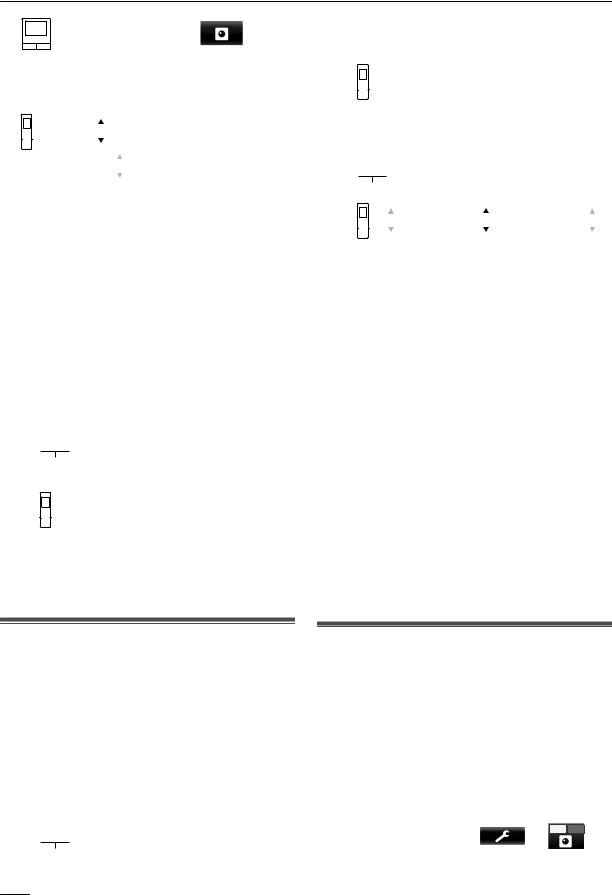
6. Using a camera
1 |
: From the top menu, touch |
and then |
|
the image. |
|
RIf the camera selection screen is displayed, touch the number of the camera that you want to monitor with and then the image.
 :
:  ®
®  : Select the camera you want to monitor with. ®
: Select the camera you want to monitor with. ®  (
(  )
)
2The images from the camera are displayed.
R Press  to speak to the monitored party.
to speak to the monitored party.
3 To end the operation, press  .
.
Features available while monitoring
–Adjust wide/zoom and pan/tilt settings (® page 33)
–Adjust sound and display settings (® page 33)
–Make a warning sound come out of the camera (® page 24)
–Record monitored images (® page 20)
Note:
RMonitoring time:
– : About 90 seconds (can be extended up to 3 minutes by performing operations during monitoring)
: About 90 seconds (can be extended up to 3 minutes by performing operations during monitoring)
– : About 3 minutes
: About 3 minutes
RIn situations where it is difficult to see images, such as when it is dark or when there is backlight, change the camera’s [Brightness] setting and activate the [Backlight compensation] setting as required. (® page 27)
–The monitoring time is about 90 seconds (can be extended up to 3 minutes by performing operations during monitoring).
 : Press
: Press  .
.
–The monitoring time is about 3 minutes.
RMaking a warning sound come out of the camera:
 : Touch
: Touch  ® [Warning sound] ® [Play sound].
® [Warning sound] ® [Play sound].
 :
:  (
(  ) ®
) ®  : "Warning" ®
: "Warning" ® 
(  )
)
Features available when a sensor is triggered
–Adjust wide/zoom and pan/tilt settings (® page 33)
–Adjust brightness settings (® page 34)
–Record monitored images (® page 20)
Note:
RImages from when camera sensors are triggered are automatically recorded to the SD card. (®
page 25)
ROnce a sensor is triggered, the next sensor detection cannot be made until about 10 seconds after the first triggered images have finished being displayed. (The time that detections are not made for can be selected. ® page 26)
RIn situations where it is difficult to see images, such as when it is dark or when there is backlight, change the camera’s [Brightness] setting and activate the [Backlight compensation] setting as required. (® page 27)
RThe volume and the types of sounds used by the [Warning sound] setting can be changed. (® page 28)
6.3 When camera sensors are triggered
When a camera sensor is triggered, the main monitor and sub monitor are notified in the follow manner.
1When a sensor is triggered the ringtone sounds and camera images are displayed for about 30 seconds.
R Talking to the other party at the camera side:
Press  .
.
RMonitoring (watching and listening) the other party without talking:
 : Touch
: Touch  .
.
6.4 Turning off camera sensor detections for specified periods of time (main monitor only)
Camera sensor detections can be turned off for specified periods of times as required.
–When camera sensor detections are turned off, notifications are not sent to the main monitor and sub monitor and images are not automatically recorded.
–When there are multiple cameras, sensor detections for all of the cameras will be turned off.
1 From the top menu, touch |
® On Off . |
24

6. Using a camera
2Touch the time you want to turn off sensor detection for.
R A beep sounds and "Off" is highlighted in yellow when settings are completed.
3 To end the operation, press  .
.
Turning sensor detection back on again
When sensor detection is turned off, it will automatically turn on again after the specified time has passed. You can turn on the sensor detection again at any time with the following operations.
1.From the top menu, touch  ® On Off to turn the sensor detection on again.
® On Off to turn the sensor detection on again.
2.To end the operation, press  .
.
Note:
RThe status of camera sensor detections can be checked in the camera information menu. (® page 13)
6.5 Recording camera images and conversations
Camera images with audio data can be recorded to an SD card. (Including doorphone images, a maximum of 3,000 images can be saved.)
6.5.1 Automatically recording images when sensors are triggered
When a sensor is triggered, images from 1 or 2 seconds*1 before the detection are automatically recorded*2 to an SD card. (® page 19)
*1 The timing when recording starts before detections depends on the [Recording before detection] setting. (® page 27)
*2 When a call is made after a sensor is triggered, audio from the main monitor or sub monitor will also be recorded.
When calls are not answered:
Recorded images are saved as unchecked images, and the notification indicator of the main monitor flashes to indicate that there are unchecked images.
Note:
RWhen there are multiple cameras, multiple incoming calls may be received at the same time. In this case, the most recent incoming call is given priority and recorded.
RWhen there is an incoming call from another camera when talking or monitoring with a camera (®
page 30, 31), you must end the call or monitoring in order to display and save the image from the incoming call.
RWhen there are multiple cameras, and another camera’s sensor is triggered whilst receiving an incoming call, the recording time of camera images (about 30 seconds maximum) may be reduced.
6.5.2 Recording images and audio until the end of calls (Record calls)
To use this function, an SD card must be inserted in the main monitor and [Record calls] must be set to [Enable] (® page 36). With this function, calls can be recorded from start to finish in 1 video file that contains audio data (max. length of about 120 seconds).
6.5.3 Manually recording monitored images and playing recorded images
The operations are the same for doorphone images.
–Manually recording monitored images. (® page 20)
–Playing recorded images. (® page 20)
25

6. Using a camera
6.6 Changing camera settings
You can change the settings to match how the camera is used.
How to change the settings (using the main monitor)
1.From the top menu of the main monitor, touch  ®
®  ® [Connected devices] ® [Camera].
® [Connected devices] ® [Camera].
2.Select the number (1 - 4) of the camera to be configured.
3.Touch the item name, function name, and setting contents.
R Operations may have to be repeated depending on the function.
4.To end the operation, press  .
.
Note:
RThe setting function screen automatically quits if an incoming call is received or if no operations are performed for about 90 seconds.
RIn the following table, < > indicates the default settings.
Item name: Sensor settings
Function name |
Setting contents and other information |
|
|
Sensor selection |
Heat sensor only, <Heat sensor + motion detection>, External sensor only, All |
|
sensors, Off (disables all sensors) |
Heat sensor detection*1 |
<Night only>, Always |
|
R Select the time period for heat sensor detection. |
|
– When [Night only] is selected, the heat sensor operates according to the settings |
|
of [Day and night switch] (® page 26). |
Motion detection*1 |
Day only, <Always> |
|
R Select the time period for motion detection. |
|
– When [Day only] is selected, motion detection operates according to the settings |
|
of [Day and night switch] (® page 26). |
Day and night switch |
<Auto>, Timer |
|
R Select whether to automatically set the day and night switch settings or set them |
|
manually to a preferred time. |
|
– This setting is active when the [Heat sensor detection] or [Motion detection] |
|
settings are set to [Night only] or [Day only]. |
|
Auto: the camera automatically switches between night and day modes depending on |
|
the brightness of the surrounding area. |
|
Timer: allows you to configure the time for the night. |
|
(After selecting [Timer], set the time with [+] and [–], and then touch [OK].) |
Time with no detection |
<10 seconds>, 30 seconds, 60 seconds |
|
R Select the time after an image is detected by a sensor or a monitored image is |
|
displayed until the sensor can make detections again. |
|
– Select a long time period if you do not want the sensor to make frequent |
|
detections. |
Heat sensor sensitivity |
High sensitivity, <Normal>, Low sensitivity, Very low sensitivity, Do not detect |
|
R If it is difficult for the sensor to make detections, select [High sensitivity]. If detections |
|
are being too frequently made, select [Low sensitivity] or [Very low sensitivity]. |
Motion detection |
High sensitivity, <Normal>, Low sensitivity, Very low sensitivity |
sensitivity |
R If you want to detect small changes in motion, select [High sensitivity]. If you do not |
|
want to detect small changes in motion, select [Low sensitivity] or [Very low |
|
sensitivity]. |
26

|
|
6. Using a camera |
||||||||||||||||
|
|
|
|
|
|
|
|
|
|
|
|
|
|
|
|
|
|
|
Function name |
|
Setting contents and other information |
||||||||||||||||
|
|
|
|
|
|
|
|
|
|
|
|
|
|
|
|
|
|
|
Motion detection range |
R |
Select the range (area) of motion detection. |
||||||||||||||||
|
|
– By setting the areas that you do not want motion to be detected in to X, you can |
||||||||||||||||
|
|
narrow down the areas that motion can be detected in. |
||||||||||||||||
|
Configuration |
|||||||||||||||||
|
1. |
Touch areas that you do not want motion to be detected in so |
|
|
|
|
|
|
||||||||||
|
|
that X is displayed on those areas. (Touch again to remove |
|
|
|
|
|
|
|
|
|
|
|
|
|
|
|
|
|
|
|
|
|
|
|
|
|||||||||||
|
|
|
|
|
|
|
|
|
|
|
|
|
|
|
|
|||
|
|
X.) |
||||||||||||||||
|
2. |
Touch [Configure]. |
||||||||||||||||
Recording before |
<1 second before>, 2 seconds before |
|||||||||||||||||
detection |
R |
Select to start recording 1 or 2 seconds before a sensor detection is made. |
||||||||||||||||
|
|
See page 23 for information about recording intervals and sensor detection |
||||||||||||||||
|
|
recordings. |
||||||||||||||||
Check sensors |
Heat sensor, Motion detection, External sensor |
|||||||||||||||||
|
R |
You can check the operations of each sensor when setting the camera, or at any |
||||||||||||||||
|
|
other time. |
||||||||||||||||
|
|
– Select the type of sensor that you want to check, trigger it, and then confirm if |
||||||||||||||||
|
|
detections were correctly made. (See the Installation Guide for the camera for |
||||||||||||||||
|
|
information about how to check the sensors.) |
||||||||||||||||
Recording test |
R |
Confirm if images are correctly recorded before and after images are recorded for |
||||||||||||||||
|
|
sensor detections. (See the Installation Guide for the camera for more information.) |
||||||||||||||||
External sensor |
<Make contact>, Break contact |
|||||||||||||||||
|
R |
When using commercially available external sensors, select the type of contact |
||||||||||||||||
|
|
points used by the sensor. |
||||||||||||||||
|
|
– Select the type of contact point according to the external sensor used and its |
||||||||||||||||
|
|
function. |
||||||||||||||||
*1 When [Day and night switch] is set to [Timer], the configured time periods are displayed above the [Night only] and [Day only] setting buttons.
Item name: Screen settings
Function name |
Setting contents and other information |
|
|
Brightness |
-3, -2, -1, <0>, +1, +2, +3 |
|
R Adjust the brightness of camera images. (The higher you set the brightness, the |
|
brighter the image.) |
|
– Make adjustments when the images are very dark or bright. |
Backlight compensation |
On, <Off> |
|
R When [On] is selected, backlight compensation is performed. However, depending |
|
on the background of the subject, the backlight compensation may not be effective. |
Automatic illumination |
When the sensor is triggered: Enable, <Only when dark>, Disable |
|
When monitoring: Enable, <Only when dark>, Disable |
Uneven colour |
On, <Off> |
prevention |
R Normally use this setting set to [Off]. Only set this setting to [On] if the colour in |
|
camera images is uneven. (When set to [On], the image quality may be reduced |
|
when it is dark.) |
Item name: Sound settings |
|
|
|
Function name |
Setting contents and other information |
|
|
Sensor trigger sound |
Sound type: <Sound a>, Sound b, Sound c |
|
Volume: <Loud>, Normal, Quiet, Mute |
|
R Select the type and volume of the sound to be made by the camera when there is |
|
a sensor detection. |
27

6. Using a camera
Function name |
|
Setting contents and other information |
|
|
|
Warning sound |
|
Sound type: <Sound a>, Sound b, Sound c |
|
|
Volume: <Loud>, Normal, Quiet |
|
|
R By operating the main monitor or sub monitor when monitoring or performing other |
|
|
actions, you can make a warning sound come out of the camera. Select the type |
|
|
and volume of the sound. |
Owner’s voice volume |
|
Loud, <Normal>, Quiet |
|
|
R Select the volume of the sound from the camera when talking or calling out to |
|
|
visitors. |
Camera mic sensitivity |
|
<High>, Normal, Low |
|
|
R When too much sound is picked up, select [Normal] or [Low]. |
Item name: Other settings |
|
|
|
|
|
Function name |
|
Setting contents and other information |
|
|
|
Indicator lamp |
|
<Always>, When transmitting, Off |
|
|
R Select how the indicator lamp lights up. |
|
|
– When [When transmitting] is selected, the lamp only lights up when the main |
|
|
monitor or sub monitor are talking or monitoring with the camera. |
Camera detection |
|
R Displays the sensor detection history. (Displays the latest 24 entries.) |
history |
|
|
Initialize settings |
|
Yes, No |
|
|
R Returns the camera’s settings to the factory default. |
|
|
– The camera remains registered to the main monitor even if the camera’s settings |
|
|
are initialized. (Registration information is not deleted.) |
28

7. Using electric locks
7.1 Connecting with electric locks
When a commercially available electric lock is connected to the main monitor, you can open a door or gate using the main monitor or the sub monitor. You can also select how long the door or gate remains open.
To use electric locks, they must be configured on the main monitor.
RA maximum of 4 electric locks can be connected to the main monitor.
RFor detailed information about connections, see the manual included with the electric lock and the Installation Guide of this product.
7.1.1 Configuring electric locks
–This operation can only be performed on the main monitor.
1From the top menu, touch  ®
®  ®
®
[Connected devices] ® [Electric lock] ® the doorphone to be configured.
R [Unlocking buzzer sound] can also be configured. (® page 37)
2Touch the electric lock to be configured and then touch the unlocking time.
3 To end the operation, press  .
.
7.1.2 Unlocking electric locks
1When talking or monitoring with the doorphone:
 : Touch
: Touch  or
or  .
.
 :
:  (
(  )
)
RWhen there are 2 electric locks connected to the same doorphone:
 : Select the electric lock to be unlocked. ®
: Select the electric lock to be unlocked. ®
 (
(  )
)
Opening another door or gate:
RAfter opening the door or gate, you can open another door or gate by touching  or
or
(sub monitor:  ).
).
Note:
RYou can only open the door or gate when talking or monitoring.
RWhen using multiple electric locks with different doorphones:
You can only open the electric locks from the doorphone that they are linked to.
29

8. Incoming call operations
8.1 When another incoming call is received - main monitor
When another incoming call is received from a doorphone or camera while talking, monitoring, or receiving an incoming call with the main monitor, the ringtone sounds and notifications are received in the following manner.
Example: When there is an incoming call from doorphone 2 while talking with doorphone 1.
B
A
Example: When there are incoming calls from doorphone 1 and camera 2 while monitoring with camera 1.
C D
A
Example: When there is an incoming call from a doorphone or camera during intercom calls.
|
|
|
E |
 Main screen
Main screen
 Doorphone button indicating that there is a new incoming call (the example shows an incoming call from doorphone 2)
Doorphone button indicating that there is a new incoming call (the example shows an incoming call from doorphone 2)
–By touching this button, you can display the image from the incoming call in the main screen.
 Camera button indicating that there is a new incoming call (the example shows an incoming call from camera 2)
Camera button indicating that there is a new incoming call (the example shows an incoming call from camera 2)
–By touching this button, you can display the image from the incoming call in the main screen.
 Sub screen indicating that there is a new incoming call (the example shows an incoming call from doorphone 1)
Sub screen indicating that there is a new incoming call (the example shows an incoming call from doorphone 1)
–By touching the sub screen, you can display the image from the sub screen in the main screen.
 Incoming call notification button
Incoming call notification button
Current action |
New incoming |
Next action |
|
call from |
|||
|
|
||
Receiving an |
Doorphone |
The display changes to the new incoming call, and the previous |
|
incoming call from a |
|
incoming call is terminated. |
|
doorphone |
|
|
|
Camera |
The existing incoming call from the doorphone is displayed in the |
||
|
|||
|
|
main screen and the new incoming call from the camera is displayed |
|
|
|
in the sub screen*1. |
|
|
|
R By touching the sub screen, you can switch the images displayed |
|
|
|
in the main screen and sub screen. |
|
Talking or monitoring |
Doorphone |
The number of the doorphone that the incoming call is from is |
|
with a doorphone |
|
displayed in the touch button (B). |
|
|
|
R When B is touched, the display changes to the new incoming call |
|
|
|
and the existing call or monitoring is terminated. |
|
|
Camera |
The incoming call from the camera is displayed in the sub screen*1. |
|
|
|
R When talking with the doorphone: |
|
|
|
– By touching the sub screen, you can switch the images |
|
|
|
displayed in the main screen and sub screen. (You can |
|
|
|
continue talking with the original call when images are |
|
|
|
switched.) |
|
|
|
R When monitoring with the doorphone: |
|
|
|
– When the sub screen is touched, the display changes to the |
|
|
|
new incoming call from the camera and the existing monitoring |
|
|
|
is terminated. |
30
